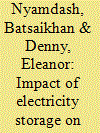| Srl | Item |
| 1 |
ID:
121370


|
|
|
|
|
| Publication |
2013.
|
| Summary/Abstract |
A key challenge internationally is the design of future electricity systems which will bring about emissions savings and fuel security at least cost. Peat is used to generate electricity in several EU countries, mainly to take advantage of indigenous resources and increase fuel mix diversity. The Irish government has introduced a target of 30% cofiring of peat and biomass by 2015. This paper assesses the feasibility of achieving this target by calculating the available indigenous biomass resource capable of being cofired; the cost of meeting the target; the benefits in terms of carbon abatement; and finally the present value in economic terms of meeting the target. Results demonstrate that Ireland has only half the necessary resource to meet the 30% target and that the net cost of doing so is greater than the cost of what is currently being paid for peat, in all of the scenarios considered. Thus, it is concluded that while it may be technically possible to meet the target by combining national resources with imported biomass this is never the least cost option, and as a result the targeted focus of Government policy may need to be reconsidered.
|
|
|
|
|
|
|
|
|
|
|
|
|
|
|
|
| 2 |
ID:
126543


|
|
|
|
|
| Publication |
2013.
|
| Summary/Abstract |
Electricity market liberalisation has become common practice internationally. The justification for this process has been to enhance competition in a market traditionally characterised by statutory monopolies in an attempt to reduce costs to end-users. This paper endeavours to see whether a pool market achieves this goal of increasing competition and reducing electricity prices. Here the electricity market is set up as a sealed bid second price auction. Theory predicts that such markets should result with firms bidding their marginal cost, thereby resulting in an efficient outcome and lower costs to consumers. The Irish electricity system with a gross pool market experiences among the highest electricity prices in Europe. Thus, we analyse the Irish pool system econometrically in order to test if the high electricity prices seen there are due to participants bidding outside of market rules or out of line with theory. Overall we do not find any evidence that the interaction between generator and the pool in the Irish electricity market is not efficient. Thus, the pool element of the market structure does not explain the high electricity prices experienced in Ireland.
|
|
|
|
|
|
|
|
|
|
|
|
|
|
|
|
| 3 |
ID:
122710


|
|
|
|
|
| Publication |
2013.
|
| Summary/Abstract |
This paper analyzes the impact of electricity storage on the production cost of a power system and the marginal cost of electricity (electricity price) using a unit commitment model. Also, real world data has been analyzed to verify the effect of storage operation on the electricity price using econometric techniques. The unit commitment model found that the deployment of a storage system reduces the fuel cost of the power system but increases the average electricity price through its effect on the power system operation. However, the reduction in the production cost was found to be less than the increase in the consumer's cost of electricity resulting in a net increase in costs due to storage. Different storage and CO2 price scenarios were investigated to study the sensitivity of these results. The regression analysis supports the unit commitment results and finds that the presence of storage increases average wholesale electricity prices for the case study system.
|
|
|
|
|
|
|
|
|
|
|
|
|
|
|
|
| 4 |
ID:
149980


|
|
|
|
|
| Summary/Abstract |
Asymmetric information may explain low energy efficiency in rented properties. Energy ratings, while a solution to the information problem, will only lead to higher efficiency levels if renter's willingness-to-pay (WTP) exceeds landlord's investment costs. Using a sample of renters from one university, this paper estimates this WTP using a discrete choice experiment where respondents choose from a hypothetical set of single-bedroom apartments that differ according to a number of attributes including the energy rating. Results show that there is a strong disutility associated with the least efficient properties and that renters will pay significantly more for efficiency improvements at the lower end of the efficiency scale. Importantly, our WTP estimates are calculated in a setting where respondents were informed about the energy rating system prior to choosing and where the rating was shown for every property. Therefore, in order to maximise the impact of energy rating systems, policymakers are encouraged to ensure that both these informational characteristics are in place.
|
|
|
|
|
|
|
|
|
|
|
|
|
|
|
|
| 5 |
ID:
181763


|
|
|
|
|
| Summary/Abstract |
Buildings in the EU are responsible for 40% of energy use, with approximately 75% of buildings classed as energy inefficient. Many energy efficiency technologies have failed to deliver on the promised savings. This paper measures the extent to which residential dwelling retrofit delivers real energy savings in Ireland using a unique dataset of whole-home energy use (n = 8,572 households) over a two-year period. It is one of the largest studies of retrofit using whole-home energy data for a general housing sample, who do not disproportionately experience fuel poverty. It uses whole-home energy data to capture potential fuel switching induced by retrofit. Finally, this study addresses concerns regarding self-selection issues associated with the decision to undergo a retrofit by comparing with a second control group of homes that received a retrofit prior to the observation period.
|
|
|
|
|
|
|
|
|
|
|
|
|
|
|
|
| 6 |
ID:
099345


|
|
|
|
|
| Publication |
2010.
|
| Summary/Abstract |
This paper studies the impact of combining wind generation and dedicated large scale energy storage on the conventional thermal plant mix and the CO2 emissions of a power system. Different strategies are proposed here in order to explore the best operational strategy for the wind and storage system in terms of its effect on the net load. Furthermore, the economic viability of combining wind and large scale storage is studied. The empirical application, using data for the Irish power system, shows that combined wind and storage reduces the participation of mid-merit plants and increases the participation of base-load plants. Moreover, storage negates some of the CO2 emissions reduction of the wind generation. It was also found that the wind and storage output can significantly reduce the variability of the net load under certain operational strategies and the optimal strategy depends on the installed wind capacity. However, in the absence of any supporting mechanism none of the storage devices were economically viable when they were combined with the wind generation on the Irish power system.
|
|
|
|
|
|
|
|
|
|
|
|
|
|
|
|